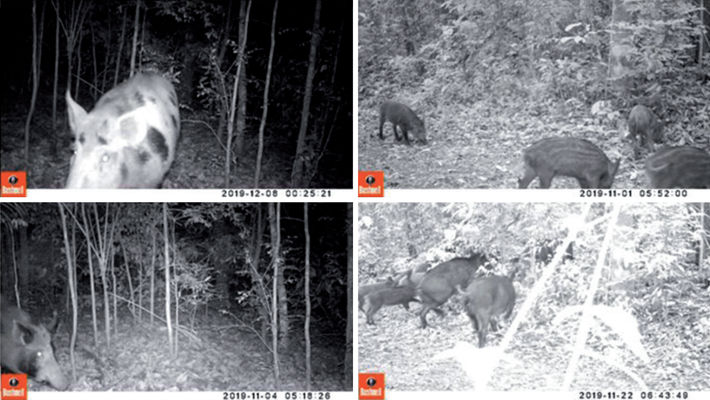Biological invasion by wild pig (Sus scrofa Linnaeus, 1758) in an Atlantic Rainforest protected area
DOI:
https://doi.org/10.31687/saremNMS.21.2.7Keywords:
Atlantic rainforest biodiversity, conservation units, ecological impact, feral pigs, invasive speciesAbstract
This is the first record of the biological invasion by wild pigs (Sus scrofa Linnaeus, 1758) in the Mata dos Godoy State Park (PEMG), an important protected area in the State of Paraná, Brazil. The PEMG landscape is identified as a priority for the conservation of the Atlantic Forest by sustaining a high richness of native species. Using camera traps, we report 21 records of wild pigs with groups of up to 26 individuals within the limits of this park. We highlight the need for quick action to contain the invasion, and thus reduce the potential negative effect on the region's natural and agricultural ecosystems. Early detection of biological invasion events is essential to guide managers to use suitable management practices and thus avoid damage to both biodiversity and local economies.
References
Acosta, D. B., C. E. Figueroa, G. P. Fernández, B. N. Carpinetti, & M. L. Merino. 2019. Genetic diversity and phylogenetic relationships in feral pig populations from Argentina. Mammalian Biology 99:27–36.
Anjos, L., L. Zanette, & E. V. Lopes. 2004. Effects of fragmentation on the birds guilds of the Atlantic Forest in North Paraná, Southern Brazil. Ornitologia Neotropical 15:137–144.
Barrios-García, M. N., & S. Ballari. 2012. Impact of wild boar (Sus scrofa) in its introduced and native range: A review. Biological Invasions 14:2283–2300.
Bayliss, H. R., S. Schindler, M. Adam, F. Essl, & W. Rabitsch. 2017. Evidence for changes in the occurrence, frequency or severity of human health impacts resulting from exposure to alien species in Europe: a systematic map. Environmental Evidences 6:21.
Bellard, C., P. Cassey, & T. M. Blackburn. 2016. Alien species as a driver of recent extinctions. Biological Letters 12:1–4.
Brasil. 2017. Portaria Interministerial MMA/MAPA N° 232, de 28 de junho de 2017 que institui o Plano Nacional de Prevenção, Controle e Monitoramento do Javali (Sus scrofa) no Brasil (Plano Javali) <http://pesquisa.in.gov.br/imprensa/jsp/visualiza/index.jsp?jornal=515&pagina=111&data=08/11/2017>.
Brondizio, E. S., J. Settele, S. Díaz, & H. T. Ngo. 2019. Global assessment report on biodiversity and ecosystem services of the Intergovernmental Science-Policy Platform on Biodiversity and Ecosystem Services. IPBES Secretariat: Bonn.
Butchart, S. H., et al. 2010. Global biodiversity: indicators of recent declines. Science 328:1164–1168.
Deberdt, A., & S. O. Scherer. 2007. O javali asselvajado: ocorrência e manejo da espécie no Brasil. Natureza & Conservação 5:31–44.
Grossi, S. F., J. F. Lui, J. E. Garcia, & F. V. Meirelles. 2006. Genetic diversity in wild (Sus scrofa scrofa) and domestic (Sus scrofa domestica) pigs and their hybrids based on polymorphism of a fragment of the D-LOOP region in the mitochondrial DNA. Genetics and Molecular Research 5:564–568.
Hegel, C. G. Z., & M. A. Marini. 2013. Sus scrofa on a fragment of Brazilian Atlantic Forest. Neotropical Biology and Conservation 8:17–24.
Heger, T., & L. Trepl. 2003. Predicting biological invasions. Biological Invasions 5:313–321.
Keiter, D. A., J. J. Mayer, & J. C. Beasley. 2016. What is in a “common” name? A call for consistent terminology for nonnative Sus scrofa. Wildlife Society Bulletin 40:384–387.
Lowe, S., M. Browne, S. Boudjelas, & M. De Poorter. 2000. 100 of the world's worst invasive alien species: a selection from the global invasive species database (Vol. 12). Invasive Species Specialist Group, Auckland.
Lowe, S., M. Browne, S. Boudjelas, & M. De Poorter. 2004. 100 of the World's Worst Invasive Alien Species. A selection from the Global Invasive Species Database. The Invasive Species Specialist Group (ISSG), a specialist group of the Species Survival Commission (SSC).
Melletti, M., & E. Meijaard (eds.). 2017. Ecology, Conservation and Management of Wild Pigs and Peccaries. Cambridge University Press, Cambridge.
MMA (Ministério do Meio Ambiente). 2018. Áreas prioritárias para conservação, uso sustentável e repartição dos benefícios da biodiversidade brasileira ou áreas prioritárias para a biodiversidade. Portaria N° 463, de 18 de dezembro de 2018.
Pedrosa, F., R. Salerno, F. V. B. Padilha, & M. Galetti. 2015. Current distribution of invasive feral pigs in Brazil: Economic impacts and ecological uncertainty. Natureza e Conservação 13:84–87.
Rosa, C. A., I. A. Pinto, & N. S. Jardim. 2018. Controle do javali na Serra da Mantiqueira: um estudo de caso no Parque Nacional do Itatiaia e RPPN Alto-Montana. Biodiversidade Brasileira 8:285–303.
Salvador, C. H., et al. 2019. First attempt to eradicate wild boar (Sus scrofa) in a protected area in Brazil. 34th Congress of the International Union of Game Biologists, September, 103–104.
Salvador, C. H., & F. Fernandez. 2017. Biological invasion of wild boar and feral pigs Sus scrofa (Suidae) in South America: Review and mapping with implications for conservation of peccaries (Tayassuidae). Ecology, Conservation and Management of Wild Pigs and Peccaries (M. Melletti & E. Meijaard, eds). Cambridge University Press, Cambridge.
Scalera, R., P. Genovesi, F. Essl, & W. Rabitsch. 2012. The impacts of invasive alien species in Europe. In: EEA technical report No. 16/2012. Copenhagen: EEA.
Simberloff, D., et al. 2013. Impacts of biological invasions: what's what and the way forward. Trends in Ecology and Evolution 28:58–66.
Walsh, J. R., S. R. Carpenter, & M. J. Vander Zanden. 2016. Invasive species triggers a massive loss of ecosystem services through a trophic cascade. Proceedings in National Academy of Sciences 113:4081–4085.

Downloads
Published
How to Cite
Issue
Section
License
Copyright (c) 2021 Marcelo O. Arasaki, Cleber G. de Góes, Renan C. de Oliveira, Alan D. Pereira, Gisele S. Porto, Gabriel B. McCrate, João Vitor Campos-Silva

This work is licensed under a Creative Commons Attribution-NonCommercial 4.0 International License.

